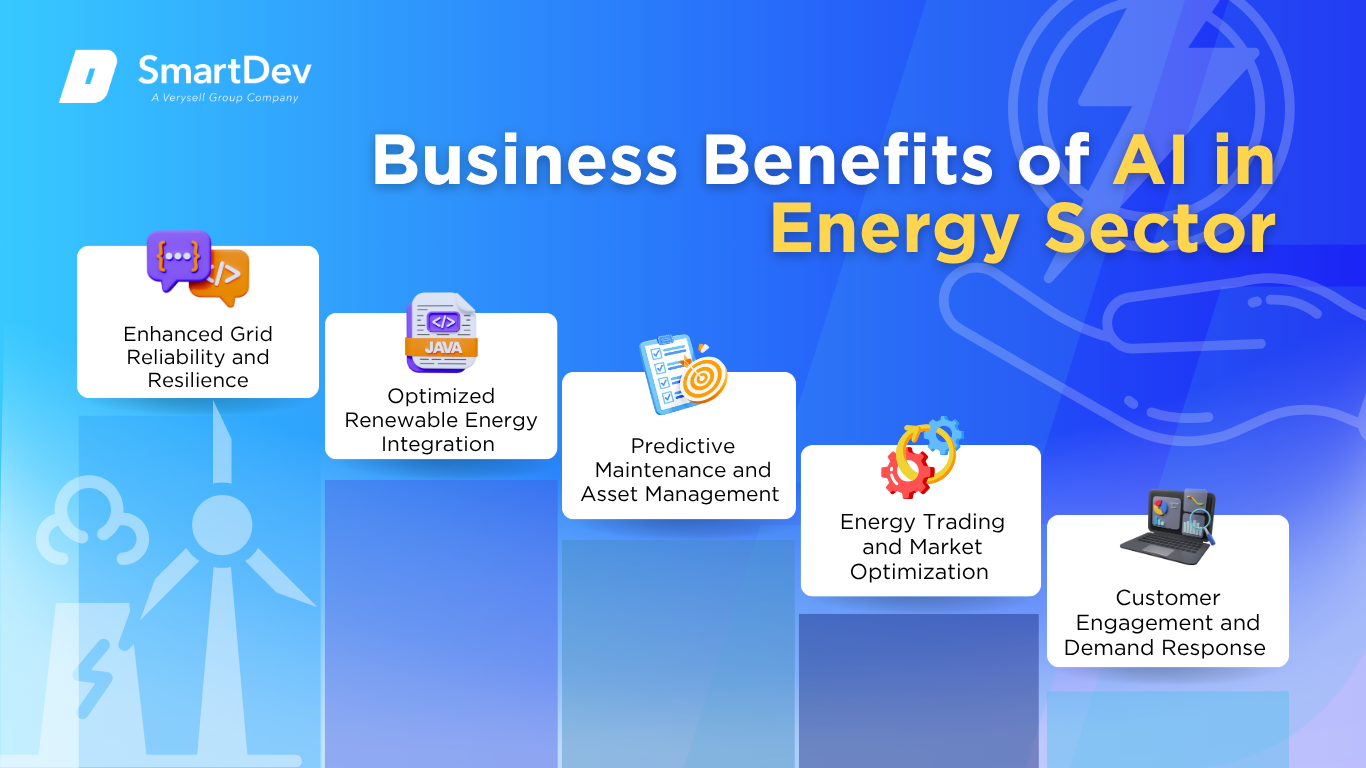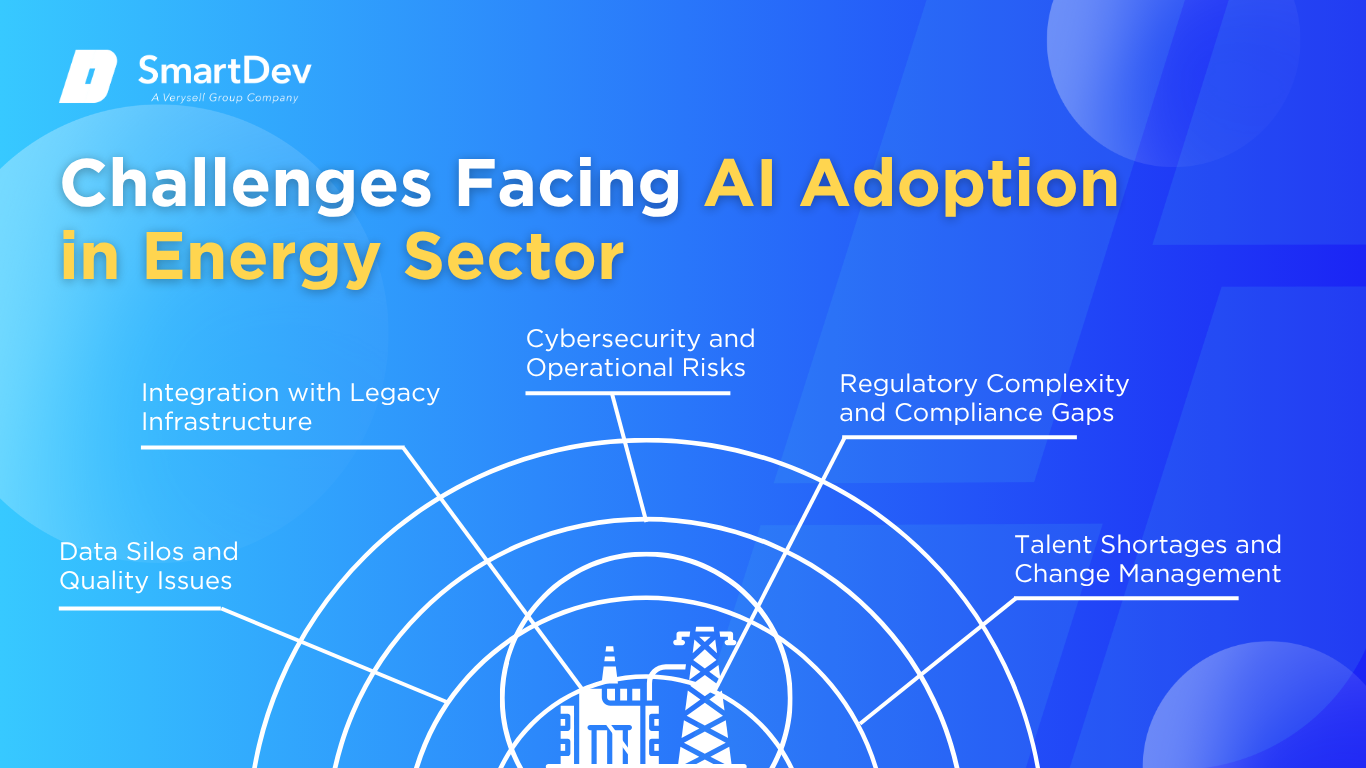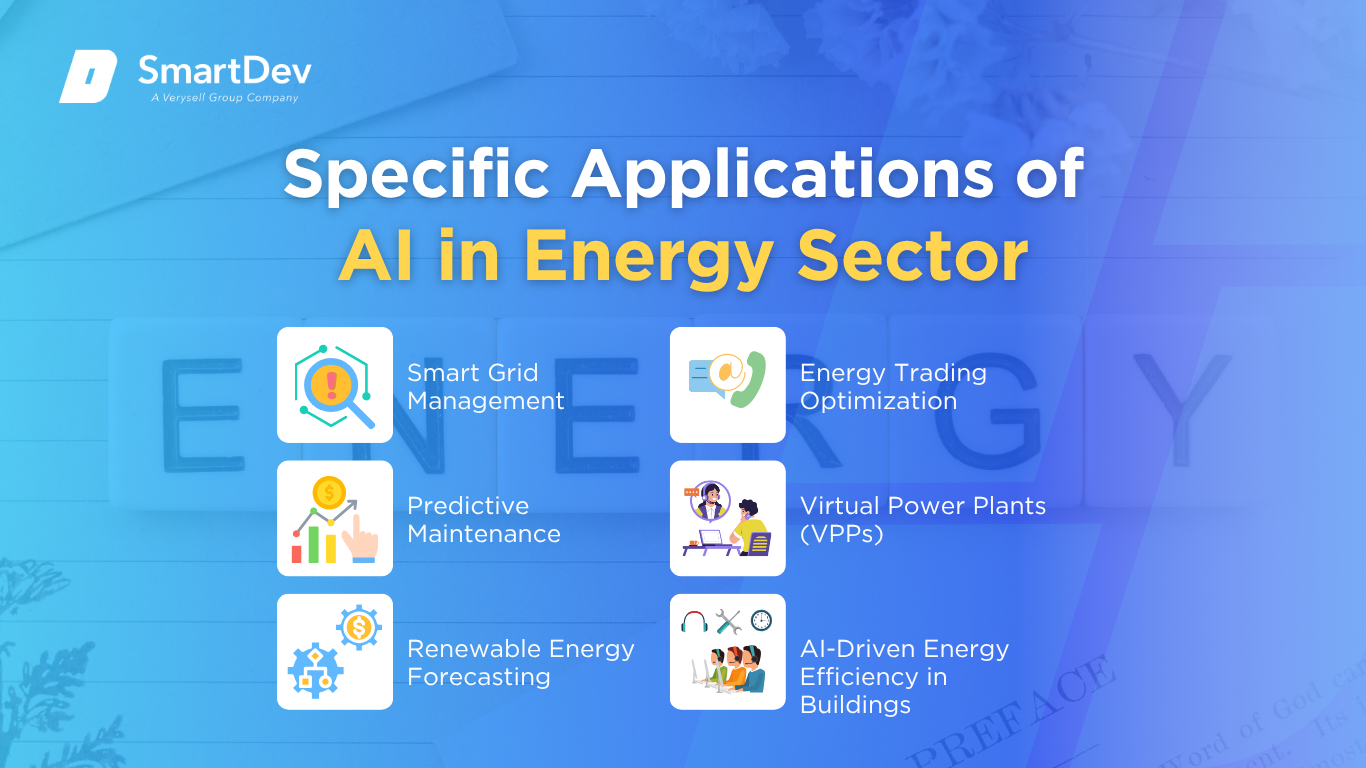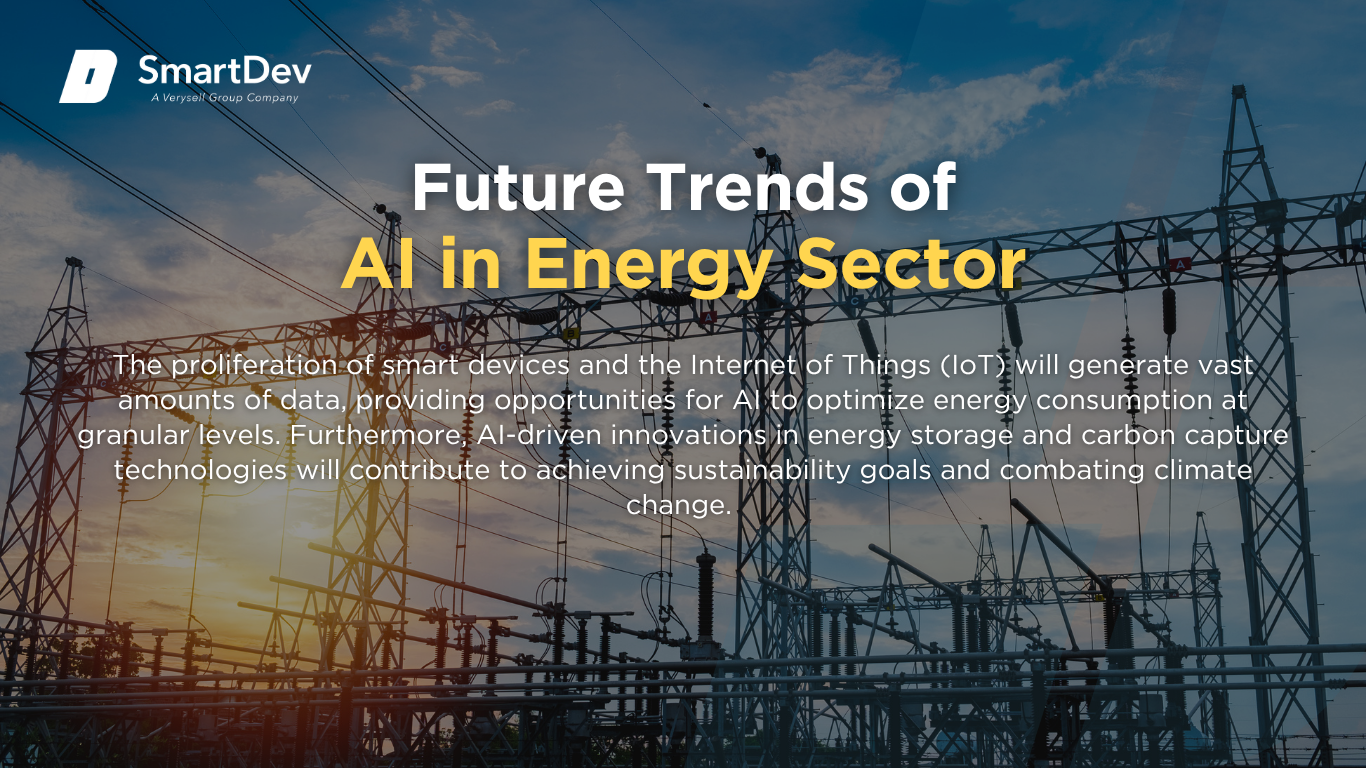Introduction
The energy sector faces mounting challenges: aging infrastructure, volatile demand, the integration of renewables, and the urgency to reduce emissions. Artificial Intelligence (AI) is emerging as a transformative force, offering solutions that enhance grid resilience, optimize asset performance, and accelerate the transition to clean energy.
This guide delves into the most impactful AI applications across the energy value chain, illustrating how they drive operational excellence and strategic innovation.
What is AI and Why Does It Matter in Energy Sector?

-
Definition of AI and Its Core Technologies
Artificial Intelligence encompasses computational systems designed to perform tasks traditionally requiring human intelligence, such as learning, reasoning, and decision-making. Core technologies include machine learning, natural language processing, and computer vision.
In the energy sector, AI leverages these technologies to analyze vast datasets from sensors, weather forecasts, and market trends, enabling predictive maintenance, demand forecasting, and real-time optimization of energy systems.
Want to explore how AI can transform your sector? Discover real-world strategies for deploying smart technologies in energy sector-visit How to Integrate AI into Your Business in 2025 to get started today and unlock the full potential of AI for your business!
-
The Growing Role of AI in Transforming Energy Sector
AI is revolutionizing grid management by enabling smart grids that adapt in real-time to fluctuations in supply and demand, enhancing reliability and efficiency.
In renewable energy, AI improves forecasting accuracy for solar and wind power generation, facilitating better integration into the grid and reducing reliance on fossil fuels. Oil and gas companies employ AI for seismic data analysis and drilling optimization, reducing exploration costs and environmental impact.
-
Key Statistics or Trends in AI Adoption
The International Energy Agency reports that AI-based fault detection can reduce outage durations by 30-50%, significantly improving grid reliability.
A McKinsey study highlights that AI applications in energy can lead to cost reductions of up to 20% and productivity gains of 70%, underscoring its economic impact.
The global market for AI in energy is projected to reach $22.6 billion by 2033, growing at a CAGR of 28.1% from $1.9 billion in 2023.
Business Benefits of AI in Energy Sector
AI is more than just a buzzword in the energy industry — it’s an enabler of smarter operations, sustainable practices, and sharper competitive edges. If you’re navigating the high-stakes environment of power production, grid management, or renewables, AI is your toolkit for turning data into results. Discover our AI-powered development services here.

-
Enhanced Grid Reliability and Resilience
Grid operators know the stakes of downtime. AI offers real-time visibility into grid performance by analyzing sensor data from substations, transformers, and transmission lines. With predictive analytics, you’re not just reacting to outages — you’re preventing them.
AI systems flag anomalies before they escalate into failures, letting your team intervene early. During extreme weather events or equipment stress, AI-driven models help maintain grid stability by adjusting loads and rerouting power dynamically, making your grid smarter and tougher.
-
Optimized Renewable Energy Integration
Wind and solar are clean but unpredictable. That’s where AI steps in. It processes weather data, historical patterns, and satellite imagery to improve forecast accuracy for renewable output. That means better planning and smoother integration into the grid.
For grid operators and utilities, this predictive power reduces the need for fossil fuel backups and minimizes curtailment. You can rely on renewables with greater confidence, unlocking their full potential while maintaining system stability and cost control.
-
Predictive Maintenance and Asset Management
Unplanned maintenance is a cost you can’t afford — literally. AI enables condition-based monitoring using IoT sensors that detect early signs of wear, overheating, or vibration anomalies in turbines, transformers, and pipelines.
This intelligence shifts your maintenance from reactive to proactive. With AI, you can extend the life of expensive assets, reduce repair costs, and keep your equipment running at peak performance. Plus, fewer outages mean better service continuity for your customers. This also applies to AI-driven automation in logistics and manufacturing
-
Energy Trading and Market Optimization
Market volatility can make or break your margins. AI gives energy traders a leg up by analyzing vast datasets — from demand patterns and weather models to regulatory changes and geopolitical news — in real time.
These insights translate into smarter bidding, pricing, and hedging strategies. Whether you’re operating in wholesale power markets or balancing supply and demand on a microgrid, AI helps you stay agile, make better decisions faster, and seize profitable opportunities ahead of the competition.
-
Customer Engagement and Demand Response
AI doesn’t just optimize systems — it personalizes experiences. Utilities and energy providers use AI to deliver customized usage insights to residential and commercial customers, helping them reduce costs and energy waste.
On the demand side, AI powers smarter DR programs. It predicts peak loads and nudges consumers to adjust usage via smart devices or incentives. That’s grid optimization with community participation — empowering your customers while supporting energy efficiency goals. Explore similar customer engagement strategies powered by AI
Challenges Facing AI Adoption in Energy Sector
While the promise of AI is compelling, real-world adoption can be tough. If you’re looking to scale AI across your energy operations, these are the roadblocks you’ll need to navigate.

-
Data Silos and Quality Issues
AI thrives on data — but the energy industry is notorious for fragmented datasets. Operational data might sit in legacy SCADA systems, while market data is housed elsewhere, and sensor data remains underutilized.
Without clean, consistent, and integrated datasets, AI models underperform or deliver misleading results. Investing in data governance frameworks, common standards, and cross-functional data access is key to unlocking AI’s full value.
-
Integration with Legacy Infrastructure
Many power plants, transmission networks, and utility systems were built long before AI was an option. Integrating AI into these legacy systems isn’t plug-and-play — it requires serious planning, system upgrades, and sometimes custom interfaces.
For leaders in energy firms, this means balancing the urgency of innovation with the cost and risk of infrastructure transformation. Hybrid solutions that allow AI overlays without full rip-and-replace strategies can provide a phased approach to modernization.
Selecting appropriate AI tools and vendors is critical to the success of your implementation. Evaluate solutions based on their compatibility with existing systems, scalability, and ease of integration. For energy providers with outdated infrastructure, modernizing legacy systems is often a necessary step before AI can deliver real-time personalization, booking automation, or predictive outcomes.
-
Cybersecurity and Operational Risks
As you add AI to the grid, you’re also increasing the digital attack surface. From AI models controlling load distribution to connected sensors in critical assets, every endpoint could be a vulnerability.
Cybersecurity must evolve in tandem with AI. That means deploying threat detection powered by AI itself, investing in secure-by-design infrastructure, and adhering to best practices in AI governance. Trust is non-negotiable when you’re managing national energy systems.
-
Regulatory Complexity and Compliance Gaps
Energy is one of the most regulated industries — and AI often outpaces regulation. Whether it’s using AI in predictive maintenance, emissions monitoring, or trading, you’re likely dealing with unclear rules or compliance hurdles.
Regulators need to catch up, but in the meantime, companies must work collaboratively with public bodies. Establishing internal governance frameworks and documenting AI decision-making processes will help you stay compliant and gain regulatory trust.
-
Talent Shortages and Change Management
AI doesn’t implement itself. You need teams that understand both energy systems and advanced analytics. Unfortunately, that hybrid talent is in short supply.
Moreover, internal resistance to AI — from field technicians to C-suite executives — can stall projects. Solving this means upskilling your workforce, hiring data-savvy engineers, and championing a change culture that sees AI as augmentation, not replacement.
Specific Applications of AI in Energy Sector

-
Smart Grid Management
AI-powered smart grids utilize machine learning algorithms to analyze vast amounts of data from sensors, meters, and other grid components. This enables real-time monitoring, predictive maintenance, and automated decision-making to enhance grid reliability and efficiency. By forecasting demand and detecting anomalies, AI helps prevent outages and optimizes energy distribution.
For instance, AI models process data from smart meters and IoT devices to predict consumption patterns, allowing utilities to adjust supply accordingly. This dynamic balancing reduces energy waste and ensures consistent service delivery. Additionally, AI facilitates the integration of distributed energy resources, such as solar panels and wind turbines, by managing their intermittent outputs effectively.
The strategic value of AI in smart grid management lies in its ability to enhance operational efficiency, reduce costs, and support the transition to renewable energy sources. However, challenges include ensuring data privacy, cybersecurity, and the need for substantial infrastructure investments. Explore AI use cases in smart infrastructure here
Real-World Example:
The U.S. Department of Energy has identified AI as a key tool for improving grid planning, permitting, operations, and resilience. By leveraging AI, utilities can better anticipate and respond to grid demands, enhancing overall system performance.
-
Predictive Maintenance
Predictive maintenance employs AI algorithms to analyze equipment data, identifying patterns that indicate potential failures before they occur. This proactive approach minimizes downtime, extends asset life, and reduces maintenance costs. Sensors collect real-time data on temperature, vibration, and other parameters, which AI models assess to predict maintenance needs.
By transitioning from reactive to predictive maintenance, energy companies can schedule interventions more effectively, avoid unexpected breakdowns, and optimize resource allocation. This not only improves reliability but also enhances safety and operational efficiency.
Implementing predictive maintenance requires investment in sensor technology and data analytics infrastructure. Additionally, ensuring data accuracy and addressing potential cybersecurity risks are critical considerations.
Real-World Example:
BP utilizes AI to monitor drilling equipment, predicting issues before they lead to failures. This approach has enabled BP to increase drilling efficiency and reduce maintenance-related downtime, contributing to significant cost savings.
-
Renewable Energy Forecasting
AI enhances the integration of renewable energy sources by providing accurate forecasts of energy production based on weather patterns and historical data. Machine learning models analyze variables such as sunlight intensity and wind speed to predict the output of solar panels and wind turbines.
Accurate forecasting allows grid operators to plan for fluctuations in renewable energy generation, ensuring a stable and reliable energy supply. This is particularly important as the share of renewables in the energy mix continues to grow.
The benefits of AI-driven forecasting include improved grid stability, optimized energy storage utilization, and reduced reliance on fossil fuel-based backup systems. However, the accuracy of forecasts depends on the quality of input data and the robustness of the AI models.
Real-World Example:
BP applies AI-driven analytics to predict output from its solar and wind operations, optimizing energy flow and ensuring efficient integration into the grid.
-
Energy Trading Optimization
AI algorithms are transforming energy trading by analyzing market data, consumption patterns, and other variables to inform trading decisions. These models can identify optimal times to buy or sell energy, manage risks, and maximize profits.
By processing vast datasets in real-time, AI enables traders to respond swiftly to market fluctuations, regulatory changes, and unforeseen events. This agility enhances competitiveness and profitability in increasingly dynamic energy markets.
The adoption of AI in energy trading necessitates robust data infrastructure and skilled personnel to interpret AI-generated insights. Additionally, transparency and explainability of AI decisions are essential for regulatory compliance and stakeholder trust.
Real-World Example:
Energi Mine employs deep learning AI models to trade and manage energy, decentralizing the global energy market and incentivizing energy conservation through blockchain-based rewards.
-
Virtual Power Plants (VPPs)
Virtual Power Plants aggregate decentralized energy resources, such as solar panels, batteries, and electric vehicles, to function as a unified power plant. AI coordinates these distributed assets, optimizing their collective output and ensuring efficient energy distribution.
By leveraging AI, VPPs can respond to real-time grid demands, balance supply and demand, and provide ancillary services. This enhances grid resilience, facilitates renewable energy integration, and reduces the need for traditional peaking power plants.
The implementation of VPPs involves challenges related to communication infrastructure, regulatory frameworks, and cybersecurity. Ensuring interoperability among diverse energy assets is also critical for effective VPP operation.
Real-World Example:
Tesla operates Virtual Power Plants in Texas and California, aggregating Powerwall batteries from participating households to provide grid support during peak demand periods. These VPPs have demonstrated the potential of AI-coordinated distributed energy resources in enhancing grid stability.
-
AI-Driven Energy Efficiency in Buildings
AI enhances energy efficiency in buildings by analyzing consumption patterns, detecting anomalies, and optimizing HVAC systems. Machine learning models process data from smart meters and sensors to identify opportunities for energy savings.
Implementing AI-driven energy management systems enables building operators to reduce energy costs, lower carbon footprints, and comply with sustainability regulations. These systems can also provide occupants with real-time feedback, encouraging energy-conscious behavior.
Challenges include the initial investment in smart infrastructure, data privacy concerns, and the need for ongoing system maintenance and updates.
Real-World Example:
Verdigris Technologies offers an AI-powered platform that monitors electrical devices in commercial buildings, providing insights to optimize energy usage and reduce waste.
Examples of AI in Energy Sector
Real-World Case Studies
Real-world applications of AI in the energy sector demonstrate its transformative impact on operations, efficiency, and sustainability. The following case studies highlight successful implementations across various domains.

1. Octopus Energy: Revolutionizing Customer Engagement with Kraken AI
Octopus Energy has transformed the energy retail landscape by leveraging its proprietary AI platform, Kraken, to enhance customer engagement and operational efficiency. Kraken integrates advanced data analytics and machine learning to manage over 70 million customer accounts across 27 countries, optimizing energy consumption and grid balancing.
One of Kraken’s standout features is “Magic Ink,” a generative AI tool that assists customer service representatives by summarizing customer interactions and suggesting appropriate responses. This tool has significantly reduced response times and improved customer satisfaction. Moreover, Kraken’s cloud-native architecture processes billions of data points daily, enabling real-time decision-making and personalized customer experiences.
The implementation of Kraken has led to measurable business outcomes, including a 40% reduction in customer service response times and a significant increase in customer retention rates. Octopus Energy’s innovative use of AI has not only enhanced customer engagement but also positioned the97 company as a leader in the transition to renewable energy.
2. GridFree AI: Modular Power Solutions for Data Centers
GridFree AI, co-founded by former Microsoft and BP executives, offers modular, off-grid “power foundry” systems that integrate gas power, battery storage, and cooling components to efficiently support data centers. These systems are designed to reduce capital and operational costs by one-third and achieve 90% energy conversion efficiency.
By eliminating traditional infrastructure like diesel generators and fan cooling systems, GridFree AI’s solutions enable rapid deployment of scalable, environmentally friendly data centers. This innovation is critical in meeting the growing energy demands of AI-driven data centers without overburdening power grids or increasing emissions.
The company’s approach has demonstrated significant outcomes, including a 50% boost in IT power availability and a substantial reduction in deployment timelines. GridFree AI’s technology is poised to play a pivotal role in the global AI infrastructure race, with initial deployments planned in the southeastern U.S. and expansion possibilities in the U.K. and Europe.
3. Rahd AI: Optimizing Oil and Gas Decommissioning
Rahd AI, based in Aberdeen, has developed an97 AI platform that transforms data from over 15,000 oil wells into actionable insights to drive down decommissioning costs in the North Sea. By analyzing environmental statements, field plans, and government data, the platform identifies the most efficient decommissioning methods, potentially saving the U.K. Treasury more than £8 billion by 2027.
The platform’s ability to process vast datasets enables it to provide strategic insights that reduce the time and resources required for decommissioning projects. In a pilot project, Rahd AI achieved an 85% reduction in time spent on data recovery, demonstrating its effectiveness in streamlining complex processes.
Rahd AI’s innovative approach has garnered attention from major energy companies and government agencies, highlighting the potential of AI to address the challenges of decommissioning aging oil and gas infrastructure. The platform’s success underscores the importance of leveraging AI to enhance efficiency and reduce costs in the energy sector.
These examples highlight the value of working with partners who understand both the technical demands of AI and the unique expectations of today’s energy sector. If you’re considering AI for your energy business, collaborating with experienced specialists can help unlock smart, scalable solutions tailored to your customer journey.
Innovative AI Solutions
As the energy sector evolves, AI-driven innovations are emerging to address complex challenges and drive efficiency. These cutting-edge solutions are not only transforming operations but also paving the way for a more sustainable energy future.
1. AI-Driven Energy Storage Optimization: Capalo AI
Capalo AI, a Finland-based startup, is revolutionizing energy storage by leveraging artificial intelligence to enhance battery efficiency. Their platform predicts renewable energy generation and consumption patterns, enabling battery storage providers to optimize charging and discharging schedules. By analyzing factors such as weather forecasts and consumer energy usage, Capalo AI ensures energy is available when demand peaks, maximizing earnings for battery owners and benefiting the grid.
The company’s innovative approach addresses the challenge of integrating intermittent renewable energy sources into the grid. By optimizing energy storage, Capalo AI contributes to grid stability and supports the transition to cleaner energy. Their profit-sharing model aligns incentives between the company and battery owners, fostering widespread adoption of their technology.
2. AI-Enhanced Building Energy Efficiency: AI4EF
AI4EF (Artificial Intelligence for Energy Efficiency) is an advanced, user-centric tool designed to support decision-making in building energy retrofitting and efficiency optimization. Leveraging machine learning and data-driven insights, AI4EF enables stakeholders such as public sector representatives, energy consultants, and building owners to model, analyze, and predict energy consumption, retrofit costs, and environmental impacts of building upgrades. The platform’s modular framework includes customizable building retrofitting, photovoltaic installation assessment, and predictive modeling tools, providing tailored recommendations for achieving energy savings and carbon reduction goals.
By facilitating data sharing and access within the ecosystem, AI4EF promotes collaboration among stakeholders. Its compatibility with open-source identity management enhances security and accessibility, making it adaptable for various regulatory and organizational contexts. This innovative solution empowers users to make informed decisions, contributing to the global transition toward sustainable energy practices.
3. AI-Powered Grid Construction Verification: Cloneable
Cloneable is at the forefront of transforming field operations in the energy sector through AI-powered automation. Their construction verification app integrates advanced technologies like LiDAR and AI object detection to ensure precision in utility construction. By enabling immediate on-site comparison of actual construction against design specifications, the app significantly reduces rework and promotes adherence to safety standards.
This solution addresses the persistent challenge of discrepancies between planned and actual construction in utility projects. By digitizing field processes, Cloneable enhances operational efficiency, improves worker safety, and ensures compliance with regulatory standards. Their approach exemplifies how AI can be harnessed to modernize infrastructure development in the energy sector.
AI-Driven Innovations Transforming Energy Sector
As the energy sector evolves, AI-driven innovations are emerging to address complex challenges and drive efficiency. These cutting-edge solutions are not only transforming operations but also paving the way for a more sustainable energy future.
-
Emerging Technologies in AI for the Energy Sector
Artificial Intelligence (AI) is rapidly transforming the energy sector, ushering in a new era of efficiency, sustainability, and innovation. From optimizing grid operations to enhancing renewable energy integration, AI technologies are revolutionizing how energy is produced, distributed, and consumed.
One notable application is in smart grid management. AI algorithms analyze vast amounts of data from sensors and smart meters to predict energy demand, detect anomalies, and optimize energy distribution. This leads to improved grid reliability and reduced energy losses.
In the realm of renewable energy, AI plays a crucial role in forecasting energy generation from sources like wind and solar. By analyzing weather patterns and historical data, AI models can predict energy output, enabling better integration of renewables into the grid and reducing reliance on fossil fuels.
-
AI’s Role in Sustainability Efforts
AI is instrumental in advancing sustainability within the energy sector. Predictive analytics powered by AI help in reducing waste by forecasting equipment failures and scheduling timely maintenance, thereby extending the lifespan of assets and minimizing downtime.
Moreover, AI optimizes energy consumption through smart systems that adjust energy usage based on real-time data. For instance, AI-driven building management systems can regulate heating, ventilation, and air conditioning (HVAC) systems to maintain comfort while minimizing energy use.
In addition, AI aids in carbon capture and storage (CCS) by modeling and optimizing the processes involved, making them more efficient and cost-effective. This contributes to reducing greenhouse gas emissions and combating climate change.
How to Implement AI in Energy Sector

Step 1. Assessing Readiness for AI Adoption
Before integrating AI into energy operations, it’s essential to assess organizational readiness. This involves evaluating existing infrastructure, data availability, and workforce capabilities. Identifying areas where AI can add the most value, such as predictive maintenance or energy forecasting, helps in prioritizing implementation efforts.
Furthermore, establishing clear objectives and aligning AI initiatives with business goals ensures that the adoption of AI technologies delivers measurable benefits. Engaging stakeholders across the organization fosters a culture of innovation and facilitates smoother transitions.
Step 2. Building a Strong Data Foundation
A robust data infrastructure is the backbone of successful AI implementation. This entails collecting high-quality data from various sources, including sensors, smart meters, and historical records. Ensuring data accuracy, consistency, and security is paramount.
Implementing data governance policies and employing data cleaning and preprocessing techniques enhance the reliability of AI models. Additionally, investing in scalable storage solutions and data management platforms supports the growing data needs of AI applications.
Step 3. Choosing the Right Tools and Vendors
Selecting appropriate AI tools and vendors is critical for successful deployment. Organizations should evaluate AI platforms based on their compatibility with existing systems, scalability, and support services. Collaborating with vendors who have experience in the energy sector can provide valuable insights and tailored solutions.
Moreover, considering open-source AI tools can offer flexibility and cost advantages. However, it’s essential to assess the community support and documentation available for these tools to ensure effective implementation and maintenance.
Step 4. Pilot Testing and Scaling Up
Initiating pilot projects allows organizations to test AI applications on a smaller scale, identify potential challenges, and refine models before full-scale deployment. These pilots provide valuable feedback and help in building confidence among stakeholders.
Upon successful pilot testing, scaling up involves integrating AI solutions across various operations and geographies. Continuous monitoring and performance evaluation ensure that the AI systems adapt to changing conditions and continue to deliver value.
Step 5. Training Teams for Successful Implementation
Empowering employees with the necessary skills to work alongside AI technologies is vital. This includes providing training programs on data analysis, machine learning concepts, and the use of AI tools. Encouraging cross-functional collaboration fosters innovation and facilitates knowledge sharing.
Additionally, creating a supportive environment where employees can experiment with AI applications promotes a culture of continuous learning and adaptability, essential for the dynamic nature of AI technologies.
Measuring the ROI of AI in Energy Sector
-
Key Metrics to Track Success
Evaluating the return on investment (ROI) of AI initiatives involves tracking various performance metrics. Productivity improvements can be measured by increased energy output, reduced downtime, and enhanced operational efficiency. Cost savings achieved through automation, predictive maintenance, and optimized energy consumption are also critical indicators.
Moreover, assessing the impact on sustainability goals, such as reductions in carbon emissions and energy waste, provides insights into the environmental benefits of AI adoption. Customer satisfaction and engagement levels can also reflect the success of AI-driven services and solutions.
-
Case Studies Demonstrating ROI
A notable example is Octopus Energy, which utilizes its AI platform, Kraken, to manage smart energy consumption and grid balancing. This approach has enabled the company to provide efficient energy services to over 7 million customers in the UK and nearly 10 million globally, demonstrating significant operational scalability and customer satisfaction.
In the oil and gas sector, BP has implemented AI to steer drill bits and predict potential problems in wells. This has resulted in the ability to drill more wells annually and allocate capital more effectively, showcasing improved operational efficiency and cost savings.
Similarly, Capalo AI, a startup focusing on energy storage, leverages AI to predict renewable energy generation and consumption. By optimizing battery charging and discharging schedules, they enhance energy availability during peak demand, maximizing earnings for battery owners and benefiting the grid.
Understanding ROI is possibly a challenge to many businesses and institutions as different in background, cost. So, if you need to dig deep about this problem, you can read AI Return on Investment (ROI): Unlocking the True Value of Artificial Intelligence for Your Business
-
Common Pitfalls and How to Avoid Them
One common challenge in AI implementation is the lack of high-quality data, which can hinder model accuracy and reliability. Addressing this requires investing in robust data collection and management systems.
Another pitfall is inadequate stakeholder engagement, leading to resistance and misalignment with organizational goals. Ensuring clear communication, involving stakeholders early in the process, and demonstrating the value of AI initiatives can mitigate these issues.
Additionally, underestimating the complexity of integrating AI into existing systems can lead to implementation delays and cost overruns. Conducting thorough assessments and planning for integration challenges are essential for smooth deployment.
Future Trends of AI in Energy Sector

-
Predictions for the Next Decade
Looking ahead, AI is poised to play an increasingly pivotal role in the energy sector. Advancements in machine learning and data analytics will enable more precise energy forecasting, enhancing grid stability and facilitating the integration of renewable energy sources.
The proliferation of smart devices and the Internet of Things (IoT) will generate vast amounts of data, providing opportunities for AI to optimize energy consumption at granular levels. Furthermore, AI-driven innovations in energy storage and carbon capture technologies will contribute to achieving sustainability goals and combating climate change.
-
How Businesses Can Stay Ahead of the Curve
To remain competitive, energy companies must embrace digital transformation and invest in AI capabilities. This includes fostering a culture of innovation, upskilling the workforce, and collaborating with technology partners to develop tailored AI solutions.
Staying informed about emerging trends and regulatory developments is also crucial. Engaging in industry forums, participating in pilot projects, and sharing best practices can help organizations adapt to the evolving energy landscape and harness the full potential of AI technologies.
Conclusion
Key Takeaways
AI is revolutionizing the energy sector by enhancing operational efficiency, enabling predictive maintenance, optimizing energy consumption, and supporting sustainability initiatives. Through real-world applications and measurable ROI, AI demonstrates its value in transforming energy production and management.
Moving Forward: A Path to Progress
For energy companies contemplating AI integration, the time to act is now. Begin by assessing organizational readiness, investing in data infrastructure, and fostering a culture that embraces innovation.
Collaborate with experienced partners to pilot AI solutions, measure outcomes, and scale successful initiatives. By proactively adopting AI technologies, businesses can position themselves at the forefront of the energy sector’s digital transformation and drive sustainable growth.
—
References:
- Top 15 Real-Life Use Cases For AI In Energy Industry
- Energy and AI – Analysis
- The Future of AI and Energy Efficiency
- Generative AI in energy and materials
- Artificial Intelligence for Energy
- AI is set to drive surging electricity demand from data centres while offering the potential to transform how the energy sector works
- Top 10 applications of AI in the energy sector







